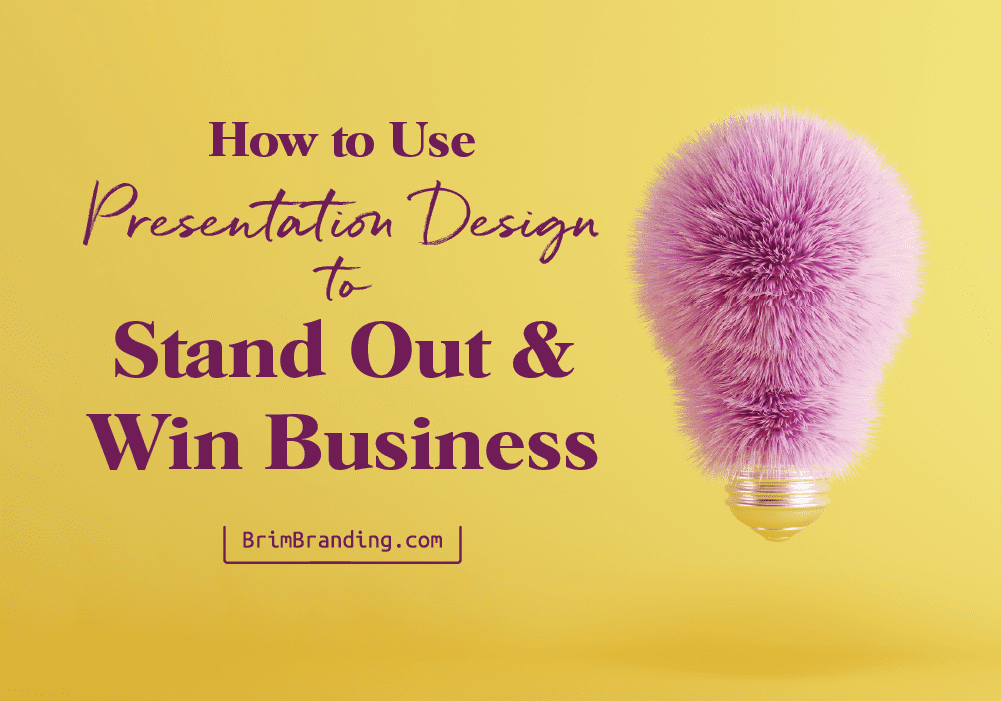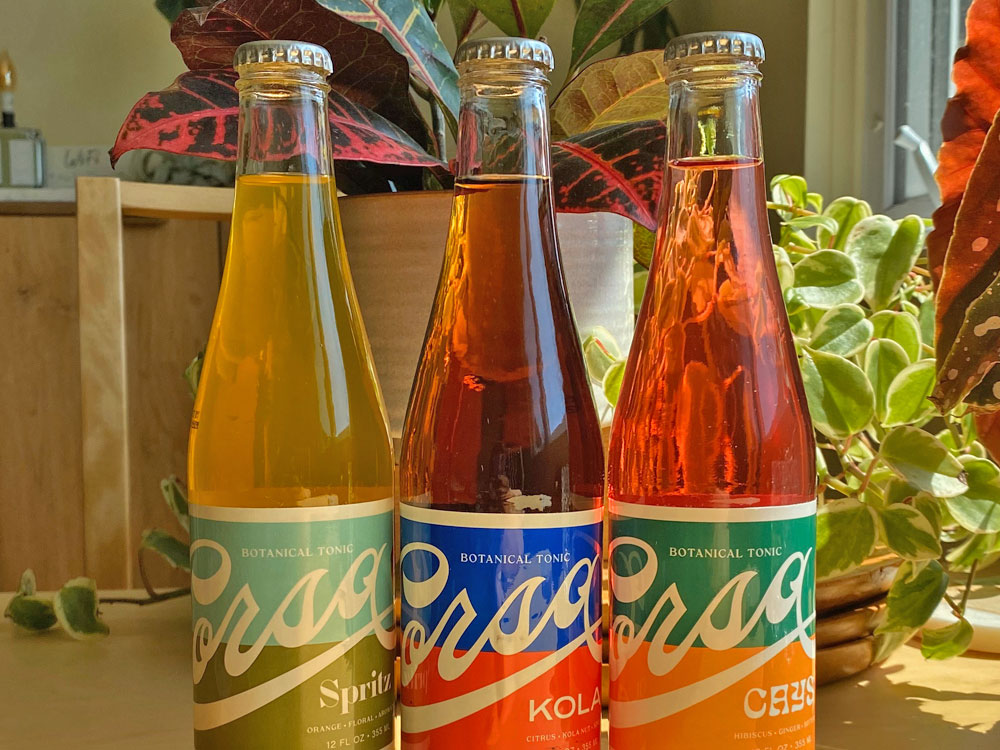How to Use Presentation Design to Stand Out and Win Business
In this blog post, I’m showing you presentation design, how to design a standout presentation to win business, pitch deck design, and basic branding for presentations.

Why Presentation Design Matters for Founders and Business Leaders
Before you even speak, your presentation design tells your audience who you are and what your brand stands for. From your presentation title and title slide design, your audience can be intrigued or impressed at best or skeptical and disinterested at worst.
In a crowded marketplace, your slides are often your brand’s first impression—especially for investors, partners, and clients. Give yourself the best opportunity to hook and impress your audience by following key steps to make sure your presentation deck is on lock.
As a brand designer with 20 years of experience designing decks, presentations, and pitch decks for multinational brands and founders, I’ll give you my playbook that I follow with every single presentation project I do to help my clients secure millions of dollars for funding and contracts.
Thoughtful, brand-aligned presentation design helps you capture attention, build trust, and communicate your message with clarity.
Presentation Design as a Brand Experience
Your Slides Are an Extension of Your Brand
A cohesive presentation design reinforces brand recognition and professionalism. If there is one word that best sums up a successful brand identity, it’s consistency. Or, in the case of ineffective brand identity design, inconsistency. Without consistency, you cannot build trust. Your audience wants to trust you. And one way to do that in a visual way is to be consistent in your presentation design. Use consistent imagery, colors, and formatting.
Align Visuals With Brand Personality
Match the tone of your presentation to your brand’s voice, whether you’re innovative, elegant, bold, approachable, or playful.
For example, compare how minimalist vs. vibrant design styles reflect different brand stories. A presentation that uses a lot of white space and a serif typeface will feel significantly different than a presentation with bold colors and graphics. What is your brand’s personality? Make sure that comes through in every element in your slides. The very format of a presentation makes it a format ripe for storytelling. Make sure to express our brand’s storytelling through design.
Start with Strategy, Not Slides
But, like I usually like to do when engaging in any kind of brand design project, let’s start with presentation strategy, not slides. If we secure our strategy, designing the slides will be easy. (Well, relatively so.)
- Clarify your goal: Is your presentation meant to inform, persuade, inspire, or sell?
- Know your audience: Understand what your audience values most.
- Build your narrative first: Outline your key message and story flow before touching design tools.
- Pro insight: The most effective pitch decks are simple, strategic, and story-driven.
Design Principles That Make Your Presentation Stand Out
Create Clear Visual Hierarchy
Using presentation design principles, you can lead your audience’s eye to what matters most. Usually, when I receive a raw deck draft with copy from a client that is ready for designed slides, I approach each slide one by one and determine one thing: What is the takeaway of this particular slide? It’s usually the title of the slide, but not always. By the time I receive the deck, usually, several members of my client’s team has had a hand in editing the deck. Sometimes, the information can get lost. (“Too many cooks” comes to mind.) As a designer with a fresh eye on the content, I can approach it with the point of view of the audience and determine whether or not the client’s intended takeaway comes through.
Nevertheless, whatever this takeaway is, I make that statement in a super large type size, at least 72 point, most of the times larger. Boom. (My mother always said, “You have to exaggerate in order to emphasize.”) This is the first thing that the audience will read. The next main point will be in a smaller size that is at least half of the headline size. This will be the second thing the audience will read. Then, any supporting body copy will be in a slightly smaller type size. The body copy is usually the smallest type size on the slide.
Use Whitespace to Add Focus and Sophistication
Clean layouts project confidence and clarity. There should not be any large blocks of copy. Anything more than a paragraph should be communicated by the actual speaker. (There are a few exceptions to this. For example, if the deck is part of training and the paragraphs of copy is a scenario exercise.)
My secret tip for instantly giving a professional presentation a design upgrade: Break out any one slide that has a ton of copy into several slides. That way, the audience takes in the information in effective bite sizes rather than being overwhelmed with large blocks of copy that are both unsightly and ineffective.
Keep It Consistent
Limit colors, fonts, and alignments to strengthen your brand presence. If you’re new to the color palette game, here’s a formula you can follow:
- Main colors – 2
- Neutral colors – 2 (can be literally black or white OR tints of the main colors)
- Accent color – 1
If you’re talking about each individual content slide, here’s a guideline you can follow:
- Neutral color for the background
- Main color for the title and body copy
- Accent color for callouts
As for fonts, limit your usage to 2 different typefaces, max. If design isn’t your strong suit, I would advise sticking to one typeface and using the different styles (bold, italic, etc.) within that typeface for variation. The reason for this is to refer back to the foundational brand concept of consistency that we covered earlier.
And as for alignments, make sure the title of each slide is in the exact same spot on the slide throughout the entire presentation. This has exceptions of course, but it’s a good rule of thumb that goes back to… that’s right: Consistency. Also, make sure lists and body copy more than 3 lines are left-aligned.
Incorporate Visual Storytelling
Use imagery, charts, and icons that clarify your message. Look at your main takeaway from each slide, and if it’s appropriate to use an image, use one that links to your main takeaway. For example, in a training presentation, if your slide’s content discusses the concept of building blocks for foundational learning, use an image of building blocks. And make sure that particular image aligns stylistically with your brand identity’s visuals. For example, if your brand visuals use bold and colorful illustrations, use bold and colorful illustrations and avoid photography that doesn’t match the look and feel of your brand. One way to easily guide your brand style decisions while designing your presentation or any other marketing tool is to have a brand style guide or stylescape on hand to reference.
Prioritize Readability
Design for screens and distance; use large type and contrast wisely. Even if your audience will be sitting up close to their screen in a video call setting, it’s important to apply the same concepts of large type in a professional presentation. Because of the nature of the form, your audience is looking for key takeaways first and then supporting information to those takeaways. Think of them taking one big bite to taste and then taking little bites to follow up. Your presentation better be delicious and easy to eat! (Yum!)
Common Presentation Design Mistakes (and How to Fix Them)
- Too much text: Simplify each slide to one main idea and key takeaway. If you still need to communication that information, either say it in your spoken script or split up that copy-heavy slide into several slides.
- Mismatched branding: Apply your logo, colors, and fonts consistently. There’s that word again: Consistent!
- Generic visuals: Replace overused stock photos with branded or custom imagery. There are a lot of stock photo sites with free licensing, and you’re welcome to use those of course. Keep in mind that those are then most likely to be less unique and more commonly used. Paid stock photo sites give you access to a larger library of unique photos that match more more consistently to your brand visuals. But if that’s not currently in the budget, look at the number of times the image has been downloaded (you can see this info on sites like Unsplash) and opt for using images that have lower download numbers.
- Poor alignment: Clean, grid-based design instantly elevates professionalism. Imagine your slide is broken up into an invisible grid. Every element of your slide – headlines, supporting text, lists – should align to a line or box in that invisible grid.
How to Infuse Branding Into Your Presentation Design
Reflect Your Brand Identity
When it comes to branding for presentations, use your brand color palette, typography, and imagery style. Like we covered earlier, make sure to stay within your brand’s established style. Using a completely different style from your established brand visuals will confuse your audience. You want them focused on your message
Design for Emotion and Connection
Ask yourself this: How do you want your audience to feel—confident, inspired, reassured? Keep brand storytelling in mind and be sure to help your audience feel a certain way while you’re communicating your message. If you’re designing a pitch deck to inspire an investor to invest in your company, you might want to make them feel compelled, urgent, or excited. If you’re designing a presentation for a town hall to engage with the community about a new mural, you might want them to feel a sense of belonging and engagement. With any successful presentation, it’s important to engage both the head and the heart.
Carry Your Brand Story Across Every Slide
Consistency in tone, visuals, and flow builds recognition and trust. Every slide carries the opportunity to express your brand storytelling whether it’s through text, images, or colors.
Best Presentation Design Tools for Non-Designers
No matter where you are on the design spectrum, there are different presentation design tools that fit your needs. If you’re a more experienced presentation designer, you can start from scratch in PowerPoint or Google Slides using their pitch deck templates as a starter. Or you can use Canva, Beautiful.ai, or Pitch for super easy presentation design software.
- Canva: Ideal for beginners; use branded templates for consistency. (Yes, there’s that word again!)
- Beautiful.ai and Pitch: Great for automated design and storytelling flow.
- Figma, Google Slides, and PowerPoint: For advanced users and team collaboration.
Pro tip: Invest in a custom presentation template to save time and keep your visuals on-brand.
When to Hire a Professional Presentation Designer
- DIY vs. professional design: Know when visual storytelling needs expert polish, especially for investor pitches, client proposals, or keynote talks.
- Benefits: Professional design elevates clarity, credibility, and emotional impact. Your willingness to invest in those extra touches communicates to your potential investors, clients, and audience that you’re committed to your messaging.
Real-World Presentation Success Stories
For example, I helped a client who specializes in leadership training. They received an RFP for a major streaming service. This streamer needed an experienced firm to train their leadership team to incorporate inclusion and identity frameworks into their strategy. For this, my client needed a bold and targeted presentation to win the business, so they hired Brim Branding as their presentation design expert. This client needed hyper-focus on content and had no time to fiddle with design. They needed professional presentation design services that would elevate their pitch and impactfully communicate their expertise in leadership training. As a result, my client handily won the lucrative contract.
In another example, I helped a client who is a creator of billion-dollar beverage brands. He wanted to secure investor funding for a new beverage he was launching. For this, my client needed a compelling deck to show potential investors a complete understanding of the shelf-to-shelf competition and full data sets to communicate a clear timeline and projected return on investment. This deck included a blend of compelling market success stories, projections, custom photo mockups of the product in hand on the shelf, all with the tone of emotional appeal and urgency. “Invest in this sure-fire success now or miss out.” As a result, my client was able to secure funding and launched the product in partnership with powerhouse influencers.
Final Thoughts — Design Is Communication, Not Decoration
Great presentation design makes your ideas not just prettier, but more powerful. It’s essential to incorporate a clear presentation design strategy for success. Remember to focus on key takeaways. Your audience should be able to sum up your message in each slide, as well as in your overall deck. They will always be asking, “What is the point? What do I need to know?” Make your presentation memorable.
How Brim Branding Can Help You
If you have a presentation that needs an extra set of eyes, book a Brew Your Brand one-on-one call for a presentation audit with me. I will review your presentation with the lens of a brand designer with 20 years of experience designing decks, presentations, and pitch decks for multinational brands and founders who have secured millions of dollars for funding and contracts.
I also offer custom presentation design services that serve your specific needs. Whether it’s fully custom decks or a template with your basic brand style and visuals for you to plug and play later, an expert, professional touch can help elevate your next pitch or keynote.
And that’s it! You just learned tips on how to use presentation design to stand out and win business. As I always tell my clients before they’re scheduled to present, go get ’em.


